
Savona is a seaport and comune in the west part of the northern Italian region of Liguria, capital of the Province of Savona, in the Riviera di Ponente on the Mediterranean Sea. Savona is the main center of the Italian Riviera.
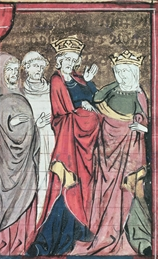
Adelaide del Vasto was countess of Sicily as the third spouse of Roger I of Sicily, and Queen consort of Jerusalem by marriage to Baldwin I of Jerusalem. She served as regent of Sicily during the minority of her son Roger II of Sicily from 1101 until 1112.

Aleram was the first Marquis of Montferrat and Liguria in Northern Italy until his death. He was son of William I of Montferrat and is mentioned in documents for the first time in 933 when he received a fief near Vercelli by Hugh of Italy. In 955 he was invested of lands in what is now the province of Alessandria.

Finale Ligure is a comune on the Gulf of Genoa, in the province of Savona, in Liguria, Italy. It is considered part of the Italian Riviera. Part of its historical center ("Finalborgo") is one of I Borghi più belli d'Italia.
Henry del Vasto, died before 1141 was a son of Manfred del Vasto, margrave of Western Liguria, and brother of Adelaide, countess of Sicily (1089–1117) and Jerusalem (1112–1117) and of Boniface, margrave of Savona and Western Liguria.

Montechiaro d'Acqui is a comune (municipality) in the Province of Alessandria in the Italian region Piedmont, located about 70 kilometres (43 mi) southeast of Turin and about 40 kilometres (25 mi) southwest of Alessandria.
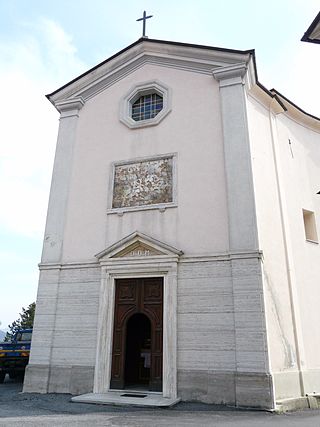
Bormida, with a population of 453 spread over an area of 22.4 square kilometres (8.6 sq mi), is a rural municipality of the Province of Savona in the Italian region Liguria. The municipality is a member of the Comunità Montana Alta Val Bormida. On May 11, 2017 it was reported that due to a declining population the town's mayor Daniele Galliano recommended a proposal to the Ligurian regional government, and not a confirmed measure, but that it hopes to enact the bonus in 2018 of offering €2,000 ($2,175) and very low rents starting at $50 per month for anyone willing to move there.

Cairo Montenotte is a comune (municipality) in the Province of Savona in Liguria, an Italian region located 50 kilometres (31 mi) west of Genoa and 20 kilometres (12 mi) northwest of Savona. Located in Val Bormida, it is a member of the Comunità Montana Alta Val Bormida. It is considered to be the main centre of Val Bormida and it has 12691 inhabitants. It is the fourth municipality in the province together with Savona, Albenga and Varazze, as well as the most popular municipality in Liguria among those without outlet on the sea. The municipal area is the biggest in the province behind Sassello, and the fifth in Liguria.

Cisano sul Neva is a comune (municipality) in the Province of Savona in the Italian region Liguria, located about 70 kilometres (43 mi) southwest of Genoa and about 35 kilometres (22 mi) southwest of Savona.

Massimino is the smallest municipality in the Province of Savona in the Italian region Liguria, located about 70 kilometres (43 mi) west of Genoa and about 35 kilometres (22 mi) west of Savona.
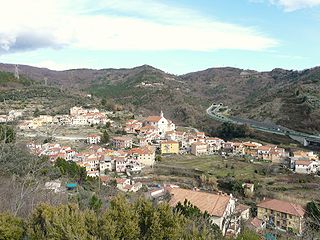
Orco Feglino is a comune (municipality) in the Province of Savona in the Italian region Liguria, located about 50 kilometres (31 mi) southwest of Genoa and about 30 kilometres (19 mi) southwest of Savona in the upper valley of the Aquila stream. It consists of the two villages of Orco and Feglino.

Sassello is a comune (municipality) in the Province of Savona in the Italian region Liguria, located about 58 kilometres (36 mi) west of Genoa and about 26 kilometres (16 mi) north of Savona in the northern side of the Ligurian Apennines. It is the birthplace of Blessed Chiara Badano.
Varazze is a comune (municipality) in the Province of Savona in the Italian region of Liguria, located about 30 kilometres (19 mi) west of Genoa and about 11 kilometres (7 mi) northeast of Savona in the Riviera di Ponente. Nearby in the Ligurian Apennines is the Monte Beigua with its Natural Regional Park.
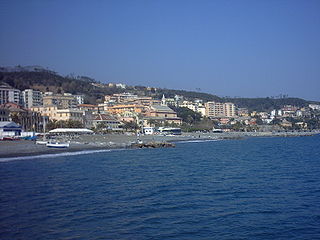
Cogoleto is a comune (municipality) in the Metropolitan City of Genoa in the Italian region Liguria, located about 25 kilometres (16 mi) west of Genova. Its territory extends from the sea to the Ligurian Apennines; it is part of the Natural Regional Park of Monte Beigua.

The March or Marquisate of Turin was a territory of medieval Italy from the mid-10th century, when it was established as the Arduinic March. It comprised several counties in Piedmont, including the counties of Turin, Auriate, Albenga and, probably, Ventimiglia. The confines of the march thus stretched across the Po Valley from the Western Alps in the north, to the Ligurian Sea.

The Aleramici were a Northern Italian noble and royal dynasty of Frankish origin which ruled various northwestern Italian territories in Piedmont and Liguria from the 10th to the 14th century, also reigning over the Kingdom of Jerusalem and the Kingdom of Thessalonica during the 12th and 13th centuries.

The Marchof Montferrat was a frontier march of the Kingdom of Italy during the Middle Ages and a state of the Holy Roman Empire. The margraviate was raised to become the Duchy of Montferrat in 1574.

The Marquisate of Incisa was a lordship of the House of Aleramici in southern Piedmont, northern Italy, which existed between the 12th and 16th centuries.
Ottone del Carretto, a patron of troubadours and an imperialist, was the margrave of Savona (c.1185–91) and podestà of the Republic of Genoa (1194–95) and of Asti (1212). He was the founder of the Del Carretto family.
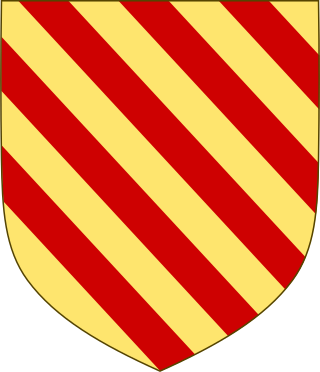
The House of Del Carretto is the name of an old and influential Italian noble family, whose members occupied many important political and ecclesiastical positions in an area of the Italian Peninsula.


















